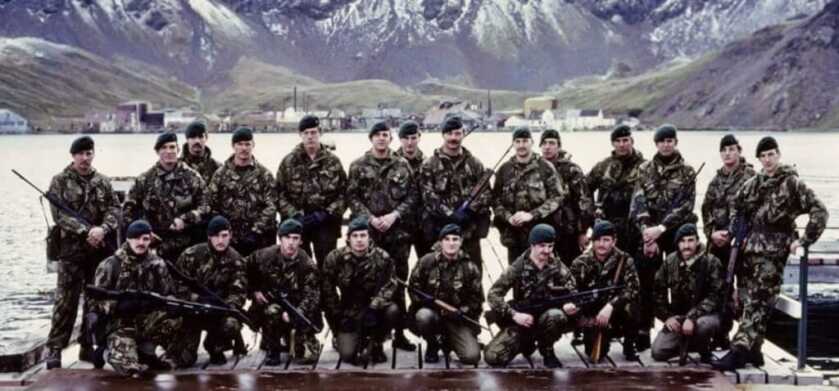

In April of 1982 twenty-three-year-old Lieutenant Keith Paul Mills commanded a 22-man detachment of Royal Marines deployed to South Georgia Island in the Falklands. South Georgia is a 104 mile-long barren rock in the Southern Atlantic some 7,600 miles from London. This deployment to one of the most desolate and remote locations in the British Realm should have been routine. Instead, LT Mills found himself as the sole line of defense against a concerted invasion by a combined arms force from the Argentine military. His performance along with that of his fellow Marines was the stuff of legend.
Setting the Stage

In March of 1982, a group of Argentine civilian scrap workers landed in Leith Harbor on Georgia Island from the transport ship ARA Bahia Buen Sucesco and planted an Argentine flag. These scrappers were there ostensibly to dismantle an abandoned whaling station. The sole British presence on the island was an Antarctic Survey team commanded by Trefor Edwards. Unknown at the time, the scrap crew also included ten Argentine Naval Commandos posing as civilian scientists.
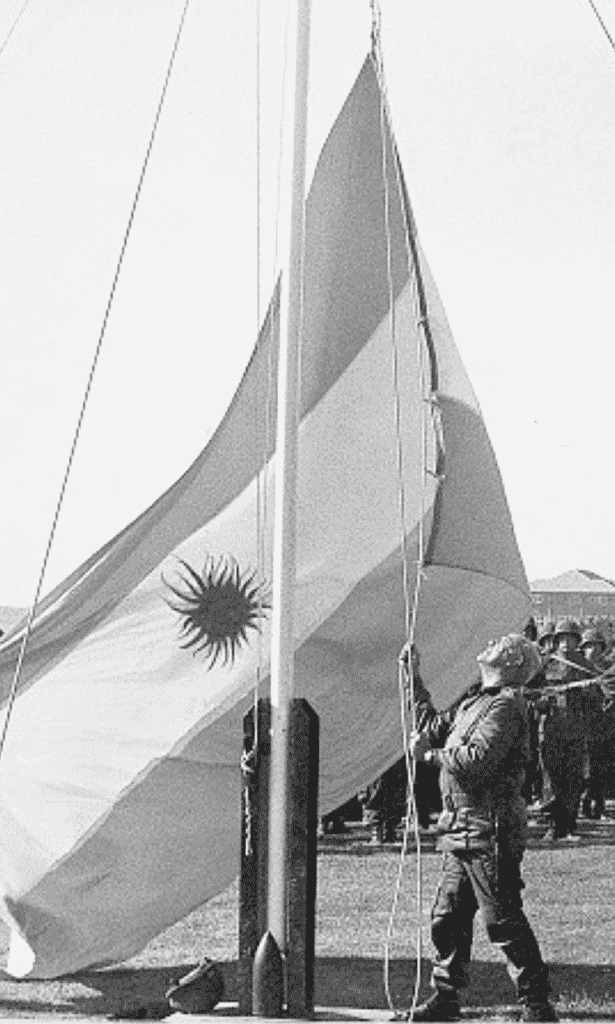
Edwards had communications with the British government in London, and he duly reported that a motley band of Argentine civilians had hoisted their flag on sovereign English soil. London demanded that the flag be removed. Edwards likely never imagined his position as an Antarctic research scientist would entail so much diplomacy, but he confronted them and the Argentines lowered their flag.

The Brits have never taken threats to their sovereignty lightly, so they dispatched the HMS Endurance, a Royal Navy ice patrol vessel, to the area to investigate. Named after Ernest Shackleton’s ship that carried his expedition to the Antarctic in 1914, the modern-day version also carried LT Mills and his contingent of Royal Marines. As was the case with most polar vessels, the Endurance was painted bright red. Her crew referred to her affectionately as The Red Plum as a result.

Unbeknownst to Mills and his Marines, this entire escapade was part of the larger covert Operation Alpha. This Argentine military operation intended to use the contracted dismantling of the whaling station to pre-position Argentine forces for a military invasion. The Argentine military government presumed that Britain had grown weary of policing its empire. They expected British Prime Minister Margaret Thatcher to give up the Falklands without a fight. They catastrophically underestimated the Iron Lady.
The Plot Thickens

Mills and his Marines landed in Leith Harbor. In response, the Argentines sortied the Corvette ARA Guerrico into the area. The Guerrico along with the ARA Bahia Buen Sucesco represented a formidable force with two helicopters, forty Argentine Marines, and a variety of heavy weapons to include an autoloading 100mm main gun.

Desperate to avoid unnecessary loss of life London instructed LT Mills to make only token resistance to any Argentine violation of British territory. Mills responded with, “Sod that, I’ll make their eyes water!” Not since BG Anthony McAuliffe responded “Nuts!” to the German demand to surrender at Bastogne during the Battle of the Bulge has a professional soldier conjured such an epic retort.
The Fuse is Lit
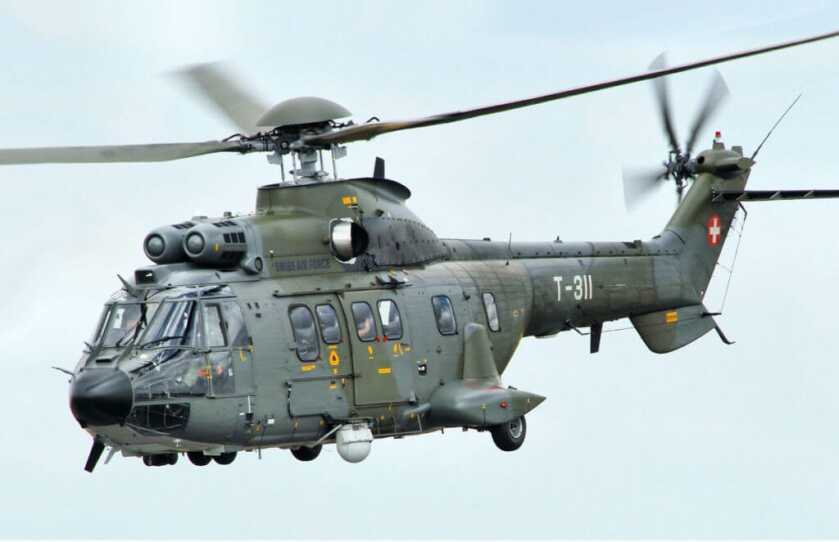
An Argentine Alouette helicopter landed in full view of the British positions and disgorged its contingent of Argentine Marines. The second aircraft, a Puma, began cycling in Marines as well. They were met with intense automatic weapons fire from the entrenched British positions.

The Puma pilot nursed his critically damaged machine back across the bay. Two Argentines were killed and another four injured in the subsequent crash. The first Argentine contingent attempted an assault on the British positions only to be pinned down by accurate and effective fire. In desperation, they called on the Corvette Guerrico for fire support.

The Guerrico steamed into the harbor and opened fire on the British positions. Recently out of refit at dry dock, the Guerrico was barely in fighting trim. Her 20mm guns jammed after a single round, the 40mm batteries got off six shots, and the 100mm main gun launched a single round before failing. The British responded with everything they had.

Heavy automatic fire from L4A4 and L7A2 light machineguns, as well as SLR semiautomatic rifles, raked the hapless Argentine warship, killing an Argentine Petty Officer and wounding two sailors. The Royal Marines hit and disabled the elevation gear on the main gun with an M72 Light Antitank Weapon. A Royal Marine gunner then skipped an 84mm Carl Gustav round off of the water and struck the vessel in the hull.

The corvette’s commander then reversed the ship and made for the harbor entrance. This gave the Royal Marines an opportunity to engage the opposite side of the vessel. A Marine marksman named SGT Peter Leech armed with an L42A1 sniper rifle shot up the bridge, causing the skipper, quartermaster, and helmsman to dive for cover. A second Carl Gustav round disabled the Guerrico’s Exocet missile launcher.
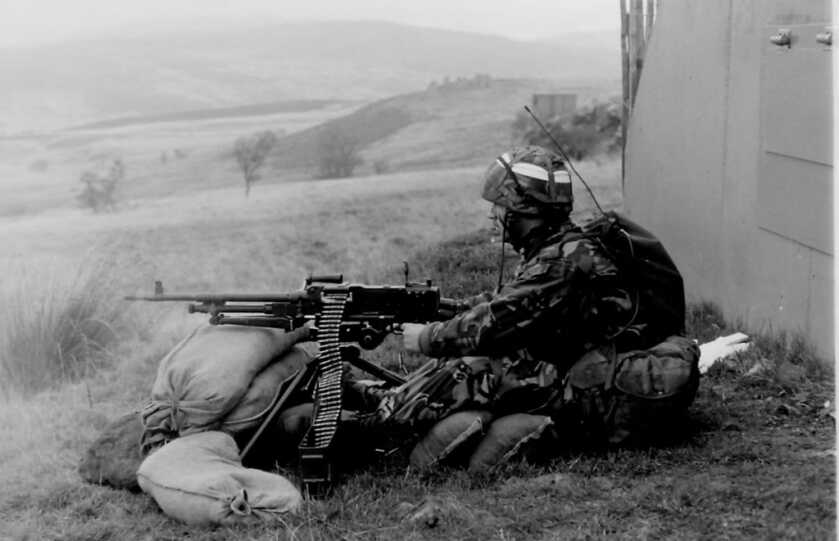
The Guerrico then left the harbor to enable repairs after her mauling at the hands of the Royal Marines. Meanwhile, the Argentine Marines engaged the English defenses with heavy small arms fire. CPL Nigel Peters caught two rounds in his arm.
The Weapons

The L1A1 SLR (Self-Loading Rifle) served as the first-line British Infantry rifle from 1954 up into the 1980s when it was supplanted by the 5.56mm L85A1. An Anglicized version of the 7.62x51mm Belgian FN FAL, the L1A1 is a gas-operated autoloading rifle that weighs 9.56 pounds empty.
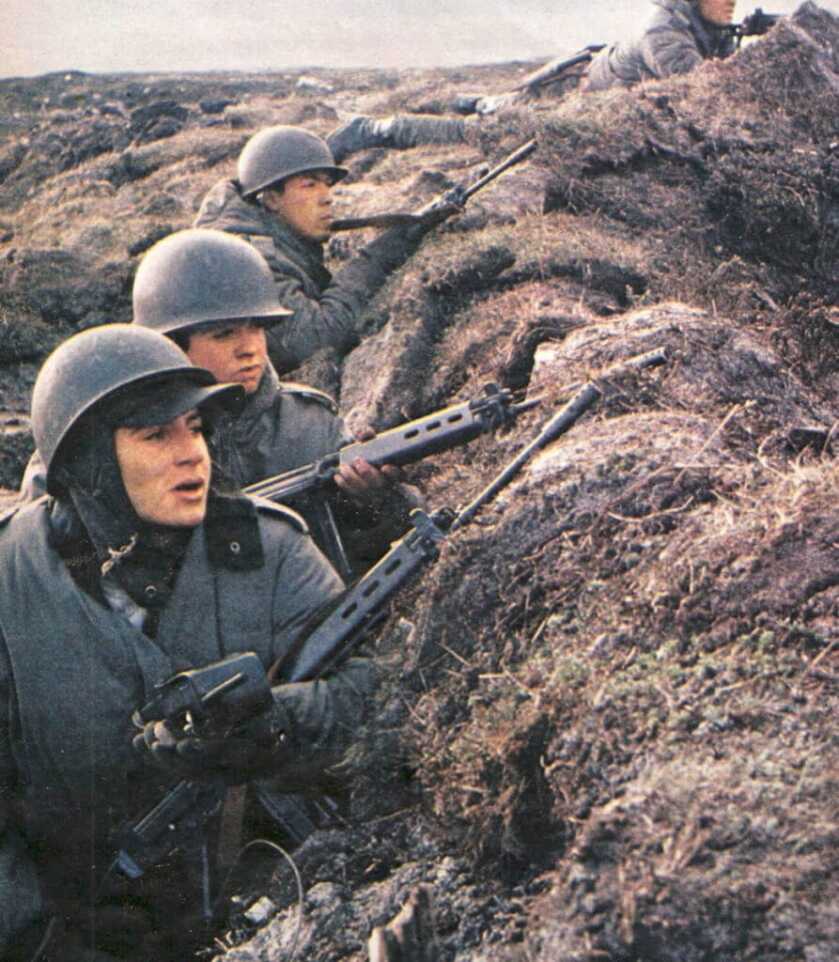
During the Falklands War, both the British and Argentine forces utilized FAL variants. Commonwealth SLR’s fired semiauto only, while the Argentine versions were selective fire. Both militaries used the same belt-fed light machineguns as well. This was one of the rare conflicts wherein both sides were almost identically equipped. Victory came down to training, logistics, leadership, and political will.

The L4A4 is a 7.62x51mm version of the WW2-era Bren light machinegun. At a glance, the L4A4 can be distinguished from its previous version by the top-mounted magazine. The L4A4 mag sports a much milder curve than that of the previous .303-firing sort. L4A4 magazines are interchangeable with those of the SLR rifle, making feeding the gun in combat a simpler logistical task. The SLR will fit and feed the 30-round L4A4 magazine, while the L4A4 will also use the stubbier SLR box.

The L7A1 is a license-built version of the FN MAG (Mitrailleuse d’Appui General) gun built by the Royal Small Arms Factory, Enfield Lock. This gas-operated 7.62x51mm full auto-only support weapon replaced the venerable Vickers gun in British service in 1957. This same action serves as the L7A2 in British service today. The US variant is the M240-series of belt-fed support weapons.

The L42A1 bolt-action sniper rifle served as the standard precision rifle for the British Ministry of Defence from 1970 until 1990. An accurized derivative of the 19th-century Lee-Metford rifle of 1888, the rear-locking action designed by James Paris Lee served the British Empire for more than a century. The L42A1 was chambered in 7.62x51mm and featured a 3.5X No32 telescopic sight with a bullet drop compensator.
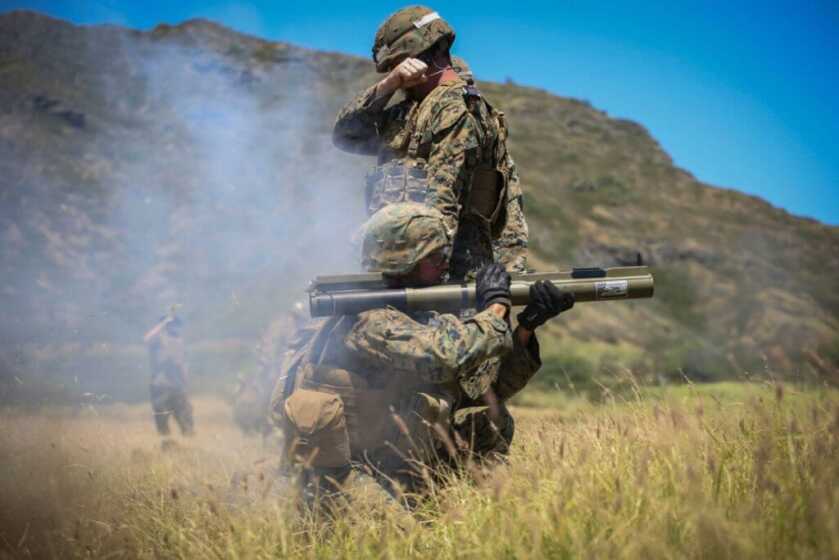
The M72 LAW (Light Antitank Weapon) is a prepackaged round of 66mm rocket-propelled ammunition encased within a disposable fiberglass and aluminum firing tube. Adopted by the US military in 1963, the M72 remains in active use around the world today. The British version employed during the Falklands War was titled the Rocket 66mm HEAT (High Explosive AntiTank) L1A1. The M72 weighs about 5.5 pounds and will penetrate a full 12 inches of steel armor.

The M2 Carl Gustav is a Swedish-designed 84mm recoilless rifle used by many Western European armies. The Carl Gustav includes a 3X optical sight and loads from the rear. At 31 pounds the M2 was brutal to hump long distances. US Army Rangers used the weapon in my day and called it the “Goose” or the “Cross,” a reference to Christ’s heavy burden at Calvary.
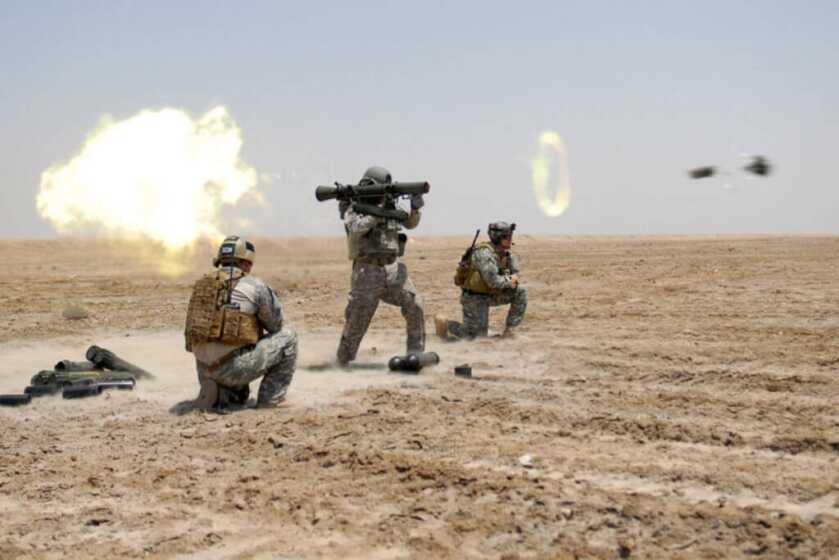
The Carl Gustav fires a relatively high-velocity round compared to comparable rocket launchers and has a longer range as a result. Unlike most rocket launchers, the Gustav can fire a wide variety of disparate rounds as well such as HEAT, High Explosive Dual Purpose, smoke, illumination, and rocket-assisted rounds. Today the latest version of the Carl Gustav sets Uncle Sam back some $20,000.
The Rest of the Story

By now the Guerrico’s main gun was marginally operational so she returned for more, this time pounding the British with heavy 100mm high explosive rounds. As the elevation gear was jammed the ship had to pull forward and back up to adjust the fall of shot. LT Mills realized that he was hopelessly outgunned. Outnumbered three-to-one and without a corvette of his own, Mills waved a white coat and nonetheless demanded the Argentines’ either surrender or return his troops safely to the UK. The Argentines treated their captives well, respecting them as fellow warriors.
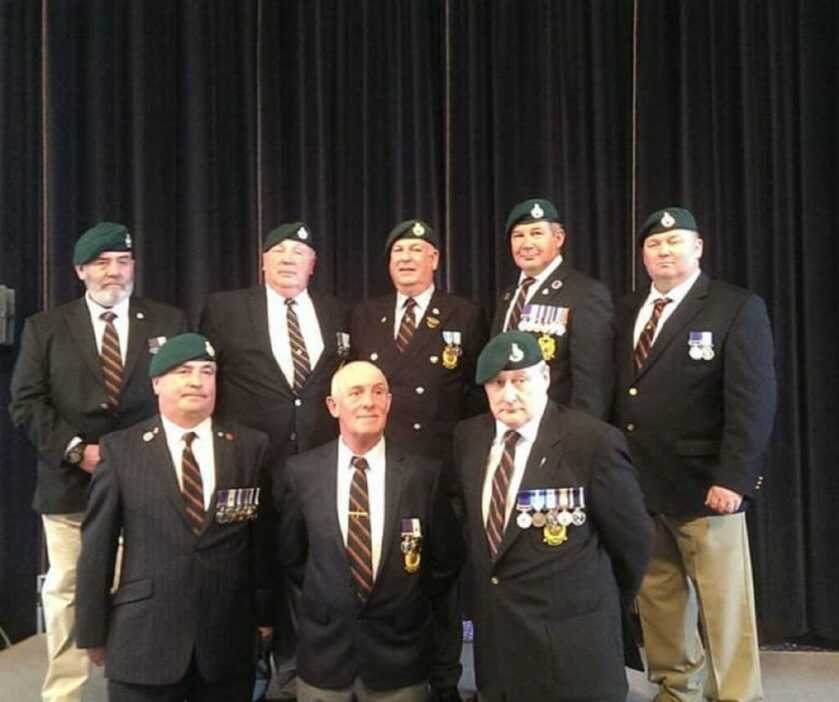
The Argentines airlifted the Royal Marine contingent to Montevideo in Uruguay and released them. Upon arrival back home the British people rightfully revered these brave Marines as heroes. LT Mills was awarded the Distinguished Service Cross, while SGT Leech was given the Distinguished Service Medal. Mills was promoted to Captain and eventually retired in 1996.

After his retirement Keith Mills has managed a series of elderly care homes in SW England. Mills Peak, a 2,050-foot mountain SW of Cape Douglas in the northern portion of Barff Peninsula on South Georgia, is named in his honor.
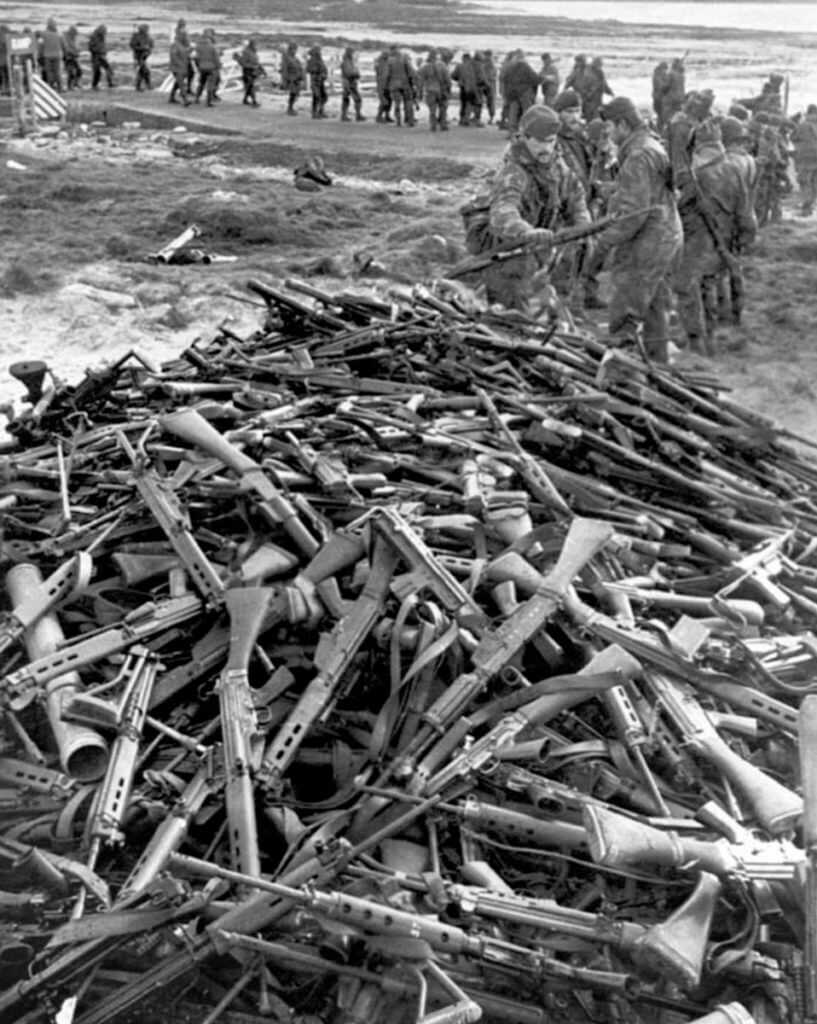


The second photo of RM on the jetty at South Georgia isn’t of any of Keith Mills’ men.
The Bootnecks shown are more likely from M Coy, 42Cdo RM that took part in Operation Paraquet (aka Op Paraquat) April 25 1982. Keith & his RM Detachment were back in UK at that time. Mills’ Marauders later rejoined HMS Endurance & took part in the last Operation of the war, Operation Keyhole, the retaking of Southern Thule.
Yeah, your right, the British that did NOT sign the Monroe Doctrine or the Declaration of Independence for that matter. In fact the British hunted the signatories of the DI and murder and the unfortunate ones that fell into their hands. I know that’s obscure history but true nonetheless. Probably not possible at the time of the MD.
I made a couple typos but I consider the point still reasonably clear. Reagan cheered of the British under Thatcher but why? What was the US interest?
Kind of reminded of when GHWB WH responded to Saddam Hussein’s concerns over slant drilling slipping into Iraq by his wealthy neighbor with the sweet crude oil and the borders dreamed up and drawn by British draftsman after WWI. At first, diplomats working for the GHWB WH (April Gillespie sp?, John Kelly?) said the US had no interest in the matter. With what seemed like a green light, Iraq launched a military campaign. Only then did Maggie speak up travelling to the WH and causing GHWB to deliver his “this will not stand” line that made a mess an oily that can never be cleaned up.
So that is the focus of my post and would appreciate any insight you have into Reagan support the British despite the Monroe Doctrine? For that matter, you probably could also give insights into the Svengali like influence Maggie on GHWB several years later?
As far as the Naval bases are concerned, I suppose deep ports like the ones in Ulster are hard to find, I’m glad to learn that the British Empire still has sentimental emotions for loyalists that the British are willing to launch a military campaign in far reaches of the globe. Too bad for the Afrikaners that they have no such protectorate.
I guess life under Argentine rule must be hell?
So why Brits gave Hong Kong to Red China so fast?
Perhaps because the pinkos have more than a couple of copters and a corvette with which to make a statement?!? At any rate, the people in Hong Kong have been “Royally” screwed (pun intended). Under Traitor Joe Xiden and his ilk, Taiwan will be next. Went to school with a good kid whose folks fought against Mao. Gonna be sad to see their efforts flushed away by our own stateside commies.
The UK gave Hong Kong back “so fast” because the UK only had a 99 year lease agreement with China on the Hong Kong pensinsula and its related islands.
The Falklands are British period! , the Argentine economy was in shambles and they wanted to distract the peasants,
Christ’s heavy burden at…Calvary. Although, the “cavalry” have carried heavy burdens at times, too.
Christ carried the cross to CALVARY, not CAVALRY. CAVALRY is a bunch of guys on horses.
I had a civilian version of the FN FAL. I traded it for a M1 Carbine (Rock Ola) and a new Colt .45 1911 with a flat upper slide. I still have both as the .45 is NIB although it is nothing special. As I recall, the rear sight on the FAL had no windage adjustment and not many appealing options for scopes at that time. The FAL seemed like a QB with a strong arm with limited accuracy.
NATO ammunition, even within spec, is 2 MOA at best. At infantry engagement distances, while both receiving as well as shooting and maneovering, the lack of an immediately adjustable windage screw isn’t something that aiming off won’t deal with. The intent is to win the firefight. For that purpose, the FN as a battle rifle instead of as a range rifle was more than accurate enough.
The idea of being able to observe the fall of shot while engaged in a TIC, then make the appropriate adjustments while you are being shot at, smoke on the battle field, panting for breath while engaged in team fire and movement, etc belongs back in the rear with the gear, on the pristine ranges where the firing points are comfy and people in the butts and spotters can give you windage adjustments to make.
There are of course exceptions to this generality on the conditions TICs are fought in, but exceptions don’t prove the rule. The Lee Enfield rifle mentioned in the story above served the Commonwealth nations superbly for over a century in colonial and world wars without having a windage adjustment in the sight – same as the FN.
I don’t recall my issued FN EVER needing a windage adjustment on subsequent trips to the range over the ears after initial zeroing. Certainly days when the wind conditions at the range would have made it a nice feature – but that’s why we were taught to hold off in various conditions anyways.
As most know, there were numerous options for scope mounting throughout the history of the FN-FAL. The simplest, easiest, and possibly strongest was simply to slide out the usual dust cover and slide in the dust cover that had a scope mount built into it (in our case, mounting the Leitz scope). That took possibly 5 – 10 seconds… easy peasy. The dust cover mounted scope was carried in a pouch on our webbing.
Yeah, your right, the British did NOT sign the Monroe Doctrine or the Declaration of Independence for that matter. In fact the British hunted the signatories of the DI and murder the unfortunate ones that fell into their hands. I know that’s obscure history but true nonetheless. Probably not possible at the time of the MD.
I made a couple typos but I consider the point still reasonably clear. Reagan cheered of the British under Thatcher but why? What was the US interest?
Kind of reminded me of when the GHWB WH responded to Saddam Hussein’s concerns over slant drilling slipping into Iraq by his wealthy neighbor with the sweet crude oil and the borders dreamed up and drawn by British draftsman after WWI. At first, diplomats working for the GHWB WH (April Gillespie sp?, John Kelly?) said the US had no interest in the matter. With what seemed like a green light, Iraq launched a military campaign. Only then did Maggie speak up travelling to the WH and causing GHWB to deliver his “this will not stand” line that made an oily mess that can never be cleaned up.
So that is the focus of my post and would appreciate any insight you have into Reagan support the British despite the Monroe Doctrine? For that matter, you probably could also give insights into the Svengali like influence Maggie also held over GHWB several years later in Iraq? Or was that just the two (GHWB, MT) getting together and setting up SH?
As far as the Naval bases are concerned, I suppose deep ports like the ones in Ulster are hard to find, I’m glad to learn that the British Empire still has sentimental emotions for loyalists that the British are willing to launch a military campaign in far reaches of the globe. Too bad for the Afrikaners that they have no such protectorate.
I guess life under Argentine rule must be hell?
Kentucky windage is fine but the FAL deserved sight like the M1 or the M-14. I doubt good sights ever lost a battle by themselves Surely, there was no pressure to produce quantity over quantity. I loved when my issued rifle was improved with the A2 sights over the A1’s and so did everyone else I ever met.
My FAL of course was a “civilian” version and I believe that most people will admit that the rear sight was very low quality. I also appreciate qualifying on the range with a good set of sights a loop sling and known distances. How did the British determine a persons competence if not on the qualifying ranges?
I imagine that were are long distance engagements on the Falkland islands with high winds blowing across. Whatever the case, I have never heard of good sights causing a battle to be lost. I also remember when the A2 replaced the A1 and never met anyone that did consider the change a positive circumstance. There were no pressures to favor quantity over quality so it made me wonder why the FAL did NOT get a set of sights to go along with an otherwise fine rifle. I would have expected a sight like those on the M1 or the M14 not a flat piece of metal with a small hole.
Of course, my experience with the FAL was as a US civilian and I do NOT regret the trade I made. I did wonder when I owned the rifle how the British qualified and established proficiency with such a Spartan device. I wondered how candidates for the rifle team, Sniper School, rifle coaches were chosen. Maybe the US and Britain have a different philosophy and I can only speak to my experiences with the USMC. I guess from what you are saying is that a form of Kentucky windage worked for the British military. I have found that current and former military people tend to favor their weapons and methods of training and if the British have a program they believe in then I am OK with that.
How is that the British presence in Argentina was NOT a violation of the Monroe Doctrine? I know Reagan and some of his modern predecessors were Anglophiles but it seems to me that one of the most important strategic naval points in SA should NOT be controlled by a European power if the Monroe Doctrine was being maintained.
Yeah, I know, Panama was handed over to China years later but in 1982 the US foreign still had some semblance of sanity.
After years of disputing the Falkland islands with Spain the British government decided to withdraw it’s presence from many overseas areas including the Falkland islands. Britain returned to the islands in 1833 ten years after the Monroe Doctrine was established in 1832.
Should read [Monroe Doctrine was established in 1823] NOT 1832
First, unless I’m mistaken, Great Britain was never a signatory to any US president’s doctrine, including James Munroe. Probably for the same reason that no president has ever decided to similarly kowtow to British foreign policy doctrine.
Also, and again unless I’m mistaken, Munroe did say his doctrine recognized existing “Old World” presence in the Americas – you know, like Great Britain and Spain as just two examples.
I’m equally sure that Great Britain and a lot of other “Old World” countries noticed that the proclaimed doctrine sure did a lot to allow the United States to then exert influence, including wars, to extend America’s power to other sovereign nations in the Americas without being disturbed in those efforts by third nations from Europe.
That would include all our Banana Republic wars – including in the Philippines, which is a long way from the Americas if we’re following a doctrine of “stay in your own neighborhood”. All of which I suppose if I were a Marxist, I could call colonialism of the capitalist kind.
BTW, if the Falkland Islands (where my great grandparents immigrated from) are supposedly an important strategic naval point, you have to ask yourself why nobody including the Brits have ever built a naval base there in well over two centuries to project navel power from.
The Falklands have become a multinational tar baby that neither the Brits nor the Argies can separate themselves from. If there wasn’t a single Brit living on that Godforsaken piece of real estate, I suspect the Brits would probably fall all over themselves giving it to the Argies… who probably wouldn’t want it all that much anyways, now that the value of whaling and places for whaling stations is long past.
But my relatives (and probably the rest who live there) firmly see themselves as British citizens and the latest generation of their British families who happen to live in an island part of England called “the Falklands”, instead of the Orkney Islands, Isles of Sky, Inner Hebrides, etc. They wouldn’t move to mainland England if you offered to buy their home and pay for the move. Which means the Falkland Islands are going to remain British for a long, long time.
I had NOT thought of this in a long time but in 1987 I was at the 1st Mar Div Sniper School CP and there was this guy from another battalion named Gerelle or something like that. He had family from Argentina and someone he was a close family or friend was in a battle and was very seriously burned. Unfortunately the young lad committed suicide after some letters home. He said a friend of his was badly burned and asked his family if he could bring him home. His family told him that would NOT be a good idea. I remember now how sad as he told the story and he indicated that many were horribly wounded. That type of info will get most peoples attention.
The Islands were in fact an important location. The islands geographic location was ideal ship repairs as like when the HMS Exeter sailed to the FI December 1939 after a battle with Kreigsmarine heavy cruiser Graf Spree. Also, in in 1942 a British Battalion was redirected from India to the FI over concerns of potential Japanese operations against the archipelago.
I did NOT know the specifics but it sure seemed logical that the the FI was vital in protecting the supporting Antarctic and subantartic islands. Turns out the FI are important and the British are less sentimental and more practical then most. I would not want to over look the WWI “Battle of the Falkland Islands” which was the first naval engagement between the Royal Navy and the German Imperial Navy. Maybe sustaining and defending such a distant but important location is a double edged sword.
Just to clarify some of the geography mentioned:
The Orkney Islands, Isle of Skye, Inner Hebrides are not part of England. They are part of Scotland which is a constituent country of the island of Great Britian. Great Britain along with Northern Ireland make up the United Kingdom of Great Britain and Northern Ireland. The Falkland Islands are a UK Overseas Territory.
In 2013 there was a referendum where the Falkland Islanders were asked whether or not they supported the continuation of their status as an Overseas Territory of the United Kingdom On a turnout of 92%, 99.8% voted remain. There were only three votes against.
After a taste of what Argentina had to offer them in 1982 it was a hardly surprising result.
The Carl Gustav at 31 pounds is indeed heavy, but when I just got out of basic back in the early eighties, I was sent to Ft. Lewis, and assigned to A 4/16, a strait leg unit, unfortunately I was always detailed to hump the M67 90mm recoilless, it weighed close to 40 Lbs. empty and was on the long side and a real pain to keep balanced on your shoulder, like humping with a bag of cement on your back. Lucky for Me, but bad for the marriage, someone liked My who knows what and moved Me to the D 4/16 Scout unit, The best training You could ask for, special weapons, demo, We got to test all the new weapons and vehicles and choppered every where, a lot of recon and sniper training, How SFC Phillips pulled off everything He did for Us, I’ll never know, really loved the Guy. But, 30 to 45 days in the field and back for two weeks and out again really put a strain on the marriage and that ended the usual way. now the rest of the story…Scouts Out, Scouts Lead the Way.
I trained with some SAS guys in Redesdale/Otterburn in ’83 and ’84 and they were fond of telling this story and others from the Falklands action … and I too loved the FAL, although it was a buggar to jump and hump. It made us appreciate the lightweight M16A2s and 5.56×45 we were issued at the time.
Great article, thanks for sharing the details of this bit of history that is likely unfamiliar to the majority of readers.